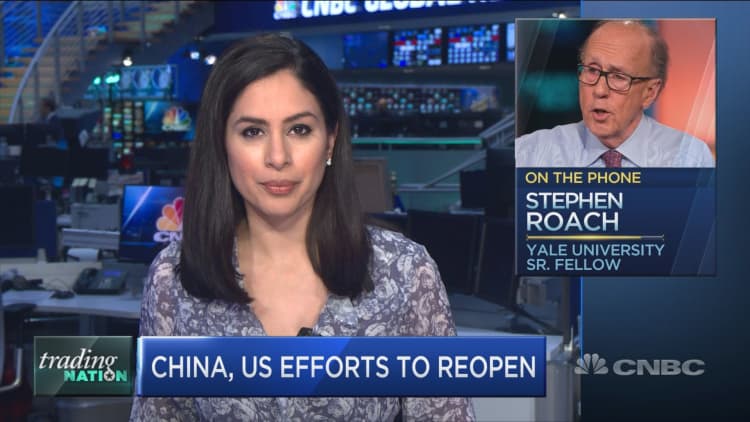BEIJING — The unemployment rate in China remained near historic highs in April, highlighting the challenges the world's second-largest economy still faces in recovering fully from the economic shock of the coronavirus.
China's official, but highly doubted, urban unemployment rate rose to 6.0% in April, from 5.9% in March, according to figures released Friday by the National Bureau of Statistics.
"The pressure on employment is rather large," bureau spokeswoman Liu Aihua told reporters at least three times during Friday's press conference. That's according to a CNBC translation of her Mandarin-language remarks.

Although monthly figures for the overall economy show some recovery, challenges remain, such as resuming work and the impact of the virus overseas, Liu said. "Right now, the trajectory of economic development still requires observation, but ... based on the results of policies for resuming work and production, we have the confidence, ability and basis for extending the momentum of recovery and improvement."
Liu noted that the bureau's survey found that at the end of April, the number of migrant workers who had returned to their jobs in the cities was about 90% of what it was a year ago. In early March, official figures showed the return to work for migrant workers from the poorest households in the country was about half of what it was a year ago.
More than half of China extended the Lunar New Year holiday by at least a week in an effort to control the Covid-19 disease, which first emerged late last year in the Chinese city of Wuhan. By early March, the virus outbreak had stalled domestically while accelerating its spread overseas. Covid-19 has now killed more than 302,000 people worldwide, including over 4,600 in China.
Slowing economy to hit more jobs
Similar lockdowns on economic activity in the U.S. sent the unemployment rate soaring to 14.7% in April, the highest since World War II and up from months of historic lows near 4% or less.
In February, the peak of the coronavirus outbreak in China, the unemployment rate jumped to a record high of 6.2%. For the 25 to 59-year-old group, the rate has hovered near 5.5% for the last three months.
The average work-hours a week per employee also fell in April by 30 minutes to 44.3 hours, the data showed.
China's unemployment data have been highly doubted, even after the country changed its methodology from worker claims to a survey in 2018 in an effort to capture more of the job losses. The urban unemployment rate has hovered near 4% to 5% for the last 20 years.
"We think that pressure on employment will continue," Bruce Pang, head of macro and strategy research at China Renaissance, said Friday. He pointed to factors such as fewer new jobs due to slower economic growth, sluggish demand for Chinese exports and a record-high number of university graduates this year.
The continued struggles of small and medium-sized enterprises, which contribute to the majority of jobs and growth in China, adds further pressure to employment. Pang pointed to third-party business registration data that showed 460,000 companies closed in the first quarter, while the establishment of 3.2 million new Chinese companies during that time still marked a nearly 29% decrease from a year ago.
Turning to new kinds of work
As the coronavirus has limited the ability of people to travel and gather, businesses and job seekers are quickly finding ways to adjust to shifts in consumer behavior.
Alibaba's logistics affiliate Cainiao said last week it has received more than 1 million job applications for managers at 30,000 new package pick-up stations across 100 cities in the country. These mini-distribution centers operate within communities such as schools and apartment complexes. Cainiao announced plans for expanding the number of stations in March and intends to increase the kinds of services they offer.
During March and April, more than half of the managers who joined were individual entrepreneurs, including household businesses and college students, according to Cainiao. The other half transitioned from traditional courier businesses, convenience stores and other small grocery shops, the company said.
For millions of other people, making such job transitions may not be that easy. But the Chinese government is intent on doing its best to ensure employment, which is critical for political stability.
Officials have made it clear that employment will remain a priority for discussions on supporting growth at China's key annual parliamentary meeting, which kicks off this year on May 22, after a delay of more than two months due to the coronavirus.
So while authorities have so far resisted a large-scale economic support plan, "the pressure from unemployment could be the main reason for stimulus escalation later this year," Larry Hu, chief China economist at Macquarie, said in a note Friday.


